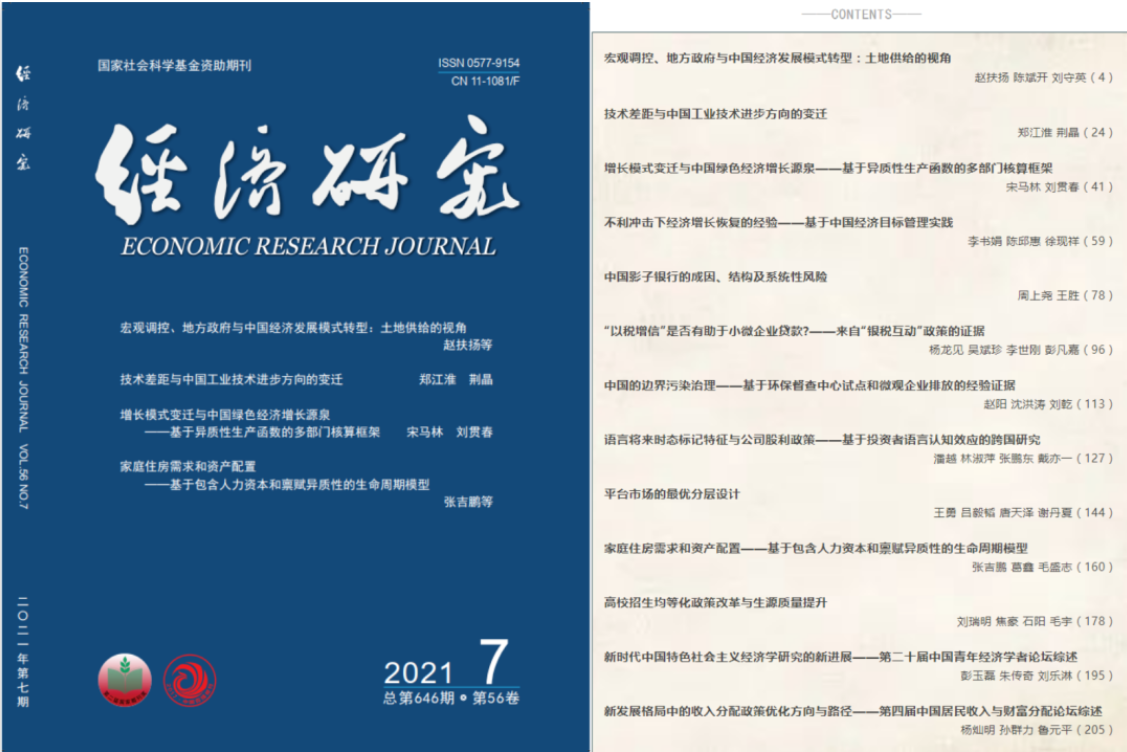岭南观点·29 不利冲击下经济增长恢复的经验——基于中国经济目标管理实践
徐现祥教授、李书娟副教授、博士后陈邱惠
我院徐现祥教授与暨南大学李书娟副教授、中山大学岭南学院博士后陈邱惠合作的学术论文《不利冲击下经济增长恢复的经验——基于中国经济目标管理实践》在经济学中文顶级期刊《经济研究》2021年第7期发表。

中国经济遭遇不利冲击后总能够较快恢复增长。从中国近三十年的经济增长实践看,无论是1998年遭遇特大洪水和亚洲金融危机,还是2008年遭遇汶川地震和国际金融危机,每次不利冲击发生后,中国经济几乎都能在一年内实现“V”型恢复。中国经济遭受不利冲击后,为什么能够较快恢复增长?在当前不利冲击频发、不确定性明显增加的环境下,这无疑是值得广泛关注的重要问题。
基于我国长期施行的经济目标管理实践,本文提出一个可能的解释:目标是底线,可防收缩。改革开放以来,我国政府一直施行增长目标导向的宏观经济管理。从党的十二大到十八大,历次党代会都明确提出经济翻番的增长目标。各级政府将其落实到具体工作,在每年年初的政府工作报告中公布当年经济增长目标,并采取一揽子政策组合。当辖区遭受不利冲击时,经济增速放缓并向下偏离期初目标;为了尽可能完成年度目标,地方政府将理性地选择加大政策力度,尽可能防止经济收缩,拉动地区经济增长,对冲不利冲击的负面影响,从而使经济在年内快速恢复增长。本文将这个过程定义为目标对冲效应,在Weitzman(1976)的框架内证明了目标对冲效应的存在。本文还发现,目标边际对冲效应等于有不利冲击时的目标边际增长效应与无冲击时的目标边际增长效应之差,从而贡献了一个识别目标边际对冲效应的简洁方法。
基于上述理论,本文采用洪水作为不利外生冲击识别目标对冲效应。本文根据水利部发布的《全国水情报告》,手工收集整理建立了全国各地级市2001-2016年的洪水数据库。根据水利部水文局界定,本文将洪水定义为“洪峰水位超过警戒线的情形”,将《全国水情报告》中主要水位站的原始洪峰数据匹配到地级市,构建地级市层面2001-2016年间的洪水指标。从空间分布看,在2001-2016年间,我国超过80%的地级市曾遭受洪水冲击。这些地级市主要分布长江流域、太湖及浙闽地区、珠江流域等,其中,长江流域最易发生洪水,有超过三分之一的洪水都发生在长江流域。从时间分布看,在2001-2016年间,我国洪水出现的时间一般是在年中,其中,超过70%的洪水冲击发生在6-8月份,而年初和年末发生洪水的概率很低。因此,本文选择洪水作为不利外生冲击,能够满足:1)经济增长目标是在年初公布,而洪水主要集中在年中,符合外生冲击的设定;2)据《中国水利统计年鉴》统计,2001-2016年间平均每年洪水受灾人口高达13489万人,造成的直接经济损失高达1696亿元,表明洪水对我国经济存在显著负面影响;3)洪水发生的地点准确、影响边界清晰,更容易被度量,在实证分析上是可行的。根据洪水数据与地级市增长目标数据的匹配情况,本文最终选择实证分析样本:2001-2016年间155个曾遭受洪水的城市作为处理组,25个相邻的未遭受洪水的城市作为对照组。
本文实证发现,在2001-2016年间,当地级市遭受洪水冲击时,洪水会导致当年经济增速平均下降约1.07个百分点。按照2001-2016年间地级市的平均GDP计算,这相当于受灾地级市的全年生产总值损失约13.13亿元。从整体看,我国地级市数量为293个,平均每年有约28.3%的地级市发生洪水,这意味着洪水平均每年对我国造成的经济损失将接近1089亿元,相当于西藏自治区2016年的全年生产总值。
本文还发现,在2001-2016年间,当遭受洪水冲击时,地方政府为确保当年的增长目标任务,平均将拉动辖区经济增速约1.11个百分点,有效对冲洪水冲击带来的经济增速下降,在宏观上就表现为经济快速恢复。本文对此进行了一系列稳健性检验,包括:1)变换无洪水城市作为对照组,排除样本选择的影响;2)采用洪水频率、洪峰水位与警戒水位差值度量洪水冲击,排除洪水指标的影响;3)采用不同增长目标度量方式,排除度量指标的影响。总体而言,本文的结论仍然稳健。
不可否认,本文的发现还面临着一些竞争性解释。比如,地方政府公布经济增长目标,同时负责统计经济数据,可能存在数据操纵。为了排除这个竞争性解释,本文采用夜间灯光亮度度量经济增长绩效,本文的发现仍然存在。再比如,我国是一个灾害频发的国家,长期以来已经发展出较为成熟的政府主导型救灾制度,经济恢复只是纯粹抗洪救灾的结果。如果这个解释成立,那么目标对冲效应将只出现在受灾的局部地区,而不是整个辖区。对此,本文识别出发生洪水的区县,在去掉洪水县样本后,考察辖区内非洪水县的目标对冲效应,本文的发现仍然存在。这说明本文的发现并非纯粹的抗洪救灾效应。
最后,本文进一步探讨目标对冲效应背后的政策组合,发现当遭受洪水冲击时,地方官员为确保经济增长目标任务,选择加大政策力度来拉动辖区经济增长。具体而言,本文实证发现,相对于相邻无洪水的地级市,遭受洪水地级市当年的财政支出占比平均提高1个百分点,相当于增加约12亿元的财政支出;金融机构贷款规模平均扩大5个百分点,相当于增加约419亿元的金融机构贷款;实际税负平均降低15个百分点,相当于减少约179亿元的税收收入。
总体而言,本文的研究揭示了经济目标管理的特殊作用。遭受不利冲击时,目标是底线,激励地方政府出台更强有力的经济政策,对冲不利冲击的负面影响,从而具有防止经济收缩的功能。在当前国内外不确定性持续增加的复杂局面下,提炼总结我国经济遭受不利冲击后快速恢复的经验,有助于我国经济在统筹发展和安全中前行。

Summary
China’s economic growth always recovered quickly from adverse shocks. Under the impact of the shock of the COVID-19,China’s economic growth dropped to 6. 8% in the first quarter of 2020 and then recovered to 3. 2% ,4. 9% and 6. 5% in the following three quarters respectively,showing a V-shaped recovery within one year. From China’s economic performance in the last three decades,we can also find similar patterns of economic recovery after every adverse shock like financial crisis in 1998 or 2008. Why can China’s economy recover quickly from these adverse shocks? This is undoubtedly an important issue that deserves widespread attention in such an increasingly complex and unstable international environment.
We propose an explanation based on the long-term practice of setting economic growth targets in China: offsetting effect of targets. Specifically,when the economy suffers adverse shocks,economic growth slows down and deviates downward from the target. In order to eliminate the gap between economic growth and the target,local officials would rationally implement target-oriented policies to cushion the impact of adverse shocks,making the economy recover within a year. We define this process as the offsetting effect of targets.
Theoretically,we prove the existence of the offsetting effect of targets within the framework of Weitzman (1976) ,and give a concise identification strategy. Considering a Weitzman framework in which local officials set a growth target and take responsibility for it,we find an optimal solution with offsetting effect of targets. We also show that the marginal offsetting effect of targets equals the difference between marginal effect of target on growth when there is an adverse shock and marginal effect of target on growth when there is no adverse shock. This means that the marginal offsetting effect of targets can be identified by comparing the marginal effect of target on growth in sample with adverse shocks and sample without adverse shocks. Based on this model,we contribute a concise identifying strategy for the offsetting effect.
We use the flood as a measure of adverse exogenous shock to identify the offsetting effect of targets. We choose this measure for three reasons. (1) Governments announce targets at the beginning of years and the flood usually occurs in the middle of years. (2) Since the location of floods is accurate and the affected boundary is clear,it is easier to be measured. (3) Existing record and studies have shown that floods have a significantly negative impact on economic development.We then manually collected the data on flood for all cities in China from the National Hydrological Report issued by the Ministry of Water Resources. After matching with the city-level data on growth targets,we have a sample that consists of 155 cities that had suffered floods and 25 neighboring cities that were not flooded from 2001 to 2016.
We empirically find that from 2001 to 2016,floods caused a decrease of annual economic growth by about 1. 07 percentage points on average,and the offsetting effect of targets was about an increase of annual growth by 1. 11 percentage points,which roughly offsets the negative impact of floods. This empirical finding obviously suggests a rapid recovery of growth from flood within one year. We conduct a series of robustness tests,including using alternative control group and treatment group,and using alternative measure of growth targets and floods.We also rule out three competitive explanations: the existence of other shocks,data manipulation,and pure flood relief effects.
Finally,we examine the mechanism of offsetting effect of targets by identifying target-oriented policies from three aspects: fiscal expenditure,tax and credit. We empirically find that compared with cities without floods,the fiscal expenditures of flooded cities increase by about one percentage point,which equals an increase of about CNY 1. 22 billion in fiscal expenditures; the tax is significantly reduced by about 15 percentage points,which equals a decrease of about CNY 17. 9 billion in tax; the scale of credit increases by about five percentage points,which equals an increase of about CNY 41. 9 billion in credit.
Our empirical findings are very robust and consistent with the theoretical predictions. They indicate that economic growth targets have set direction for local government policies in China,which are conducive to the resistance against adverse shocks and stabilization of the economy. From the target of establishing well-off society at the beginning of the reform and opening-up to the target of high-quality development at the 19th National Congress of the CPC,each target has set a direction and a development path. In this current situation of global uncertainty,the experience of China's rapid recovery of growth can help to better understand the special role of target management.

徐现祥
经济学博士,中山大学岭南学院经济学教授。研究领域主要涉及制度与政治经济学、中国经济转型与发展。在地方官员发展行为、政务服务市场等方面的研究在学界产生了较广泛影响。
陈邱惠




